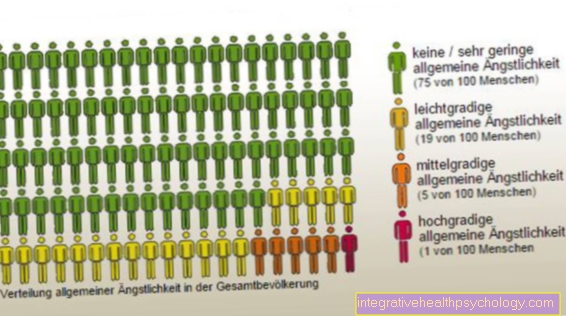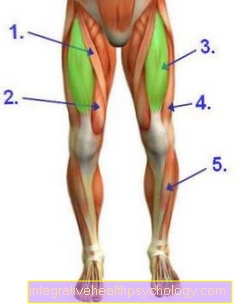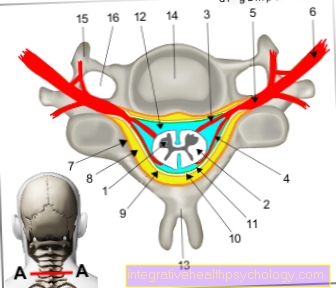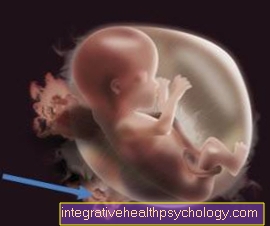Proper nutrition for your baby
introduction
The baby is fed with special baby food or baby food. It is subject to strict requirements and contains all the necessary ingredients that the baby needs to grow up. Baby food must therefore contain neither bacteria nor harmful substances. In addition, certain maximum amounts of fat and carbohydrates must not be exceeded, and certain minimum amounts of minerals and vitamins must not be undercut.
The most natural food is breast milk, which is better tailored to the needs of the infant than industrially manufactured food. The industrially produced baby food can be divided into starting food, follow-on food and complementary food, depending on the month of life in which it is fed.

First year - an overview
In the first year of life, babies need a very special diet, as a lot of energy and nutrients are needed for development and growth during this time. In addition, the digestive system is not yet sufficiently and fully developed, so that a slow approach to the many different foods is essential.
After birth, most babies get their nutrients through breastfeeding from breast milk. In the first four to six months of life, breast milk can meet all of the infant's needs with the exception of vitamins K and D. An additional supply of food or fluids is therefore not necessary.
Milk production is stimulated by the baby's sucking reflex. Breast milk has a protective and anti-inflammatory effect on the infant's immune system. The risk of diarrhea, otitis media, sudden infant death syndrome and obesity in later childhood can be reduced by breastfeeding alone. Positive effects on the health of the mother are also described. Most relevant is the risk reduction for breast and ovarian cancer. Breastfeeding can also build and strengthen the mother-child relationship.
Partial breastfeeding with additional feeding of baby milk is also possible. Fortunately, if breastfeeding is not possible or desired, there are industrially manufactured alternatives. This can also be fed if you are unable to gain sufficient weight through breast milk alone.
Cow's milk serves as the protein source for this baby food. In the long run, breast milk does not contain enough iron, so that additional feeding is necessary after the first six months at the latest. However, breastfeeding can continue until the mother and child decide to refrain from it. The complementary food initially in the form of vegetable-potato-meat porridge covers the child's increasing energy and nutritional needs.
Read more on this topic: Constipation in the baby
Nutrition 0-4 months
In the first months of life they are Digestion and the digestive system are not yet sufficiently mature. For example, there is no intestinal flora yet. Many of the digestive enzymes are also not yet formed. Therefore, babies are allowed in the first phase of life only special infant formula or breast milk receive.
Most babies are born in the first few weeks of life up to 12 times a day applied to the chest or bottle. During this time, breast milk contains all the important nutrients in the necessary composition that the child needs to grow up healthily. An adaptation to the special needs of the infant happens all by itself.
The Breast milk equips the baby in the first months of life additionally with a good immune defense off and has an anti-inflammatory effect. Diseases and Allergies can so preventive become. Vitamins K and D that are missing in breast milk must be supplied separately. The pediatrician gives you all the relevant information.
Breastfeeding is not possible or desirable industrially manufactured starter foods to be fed. This are not to be equated with breast milk, protrude but close to them and meet strict requirements that cannot be guaranteed by self-prepared milk formula. The composition of the starter foods also corresponds to the needs of the infant.
Initial foods labeled "Pre" are very similar to breast milk, as the protein content has been adjusted accordingly. They also contain as Carbohydrate-based only lactose.
The starting formulas with the Digit "1" contain, however in addition to milk sugar, small amounts of starchwhich has a very filling effect. Their protein content is the same as that of breast milk and they contain lactose as the only carbohydrate.
In the case of partial breastfeeding, the breast can be given first and then the bottle. Breast milk, Pre or 1 foods are very suitable as baby food in the first months of life and beyond for the first year of life.
From the 4th month
The baby's diet can be expanded after the fourth month of life at the earliest. Many recommendations even speak of the fifth month of life as the earliest point in time. The milk meals are gradually reduced and replaced by so-called complementary foods. However, the baby should not be overwhelmed. If there is the impression that the child is not yet ready, the breast or the bottle can continue to be given up to a maximum of the seventh month. If this type of food intake is no longer sufficient for the child, complementary food can be started.
Complementary foods include vegetables, fruit, potatoes, any form of grain or meat. However, the foods are not all fed at the same time from the 4th month, but gradually expanded at certain times. Breastfeeding or giving baby food can also be passed on until the end of the first year, for example as breakfast. For many parents and paediatricians, the fourth month of life is set too early to start solids. This decision should therefore be made individually and in consultation with the pediatrician.
Read more on the subject at: Complementary food for babies
From the 6th month
The feeding of complementary foods has usually already started from the 6th month. The Introduction is typically between the 5th and 7th month of life and becomes necessary because at this age the nutritional requirements can no longer be covered by breast milk or bottles alone.
The baby is given complementary food as the first food preferably a vegetable mash for example from carrots, cauliflower or broccoli. The amount of porridge is gradually increased and additional ingredients are gradually added. After a week with vegetable porridge, can then Potatoes attached become. After that, the addition of meat can be tried that can be replaced with fish every two to three weeks.
The choice of porridge should be as varied as possible be. At the end of the first month with complementary foods, the porridge has usually replaced a whole milk meal at noon. However, some children adapt to it faster than others.
The ones already mentioned Follow-on formulas become as a supplement to complementary foods viewed. You will be with the Designation "2" or „3“ offered. However, it is not necessary to feed follow-on foods as dairy foods. The baby receives all the necessary nutrients even without this follow-on formula.
Important What is to be known, however, is that the Follow-on formula from 6 months of age at the earliest may be given and under no circumstances a substitute for breast milk or the infant formula in the first six months of life.
From the 8th month
About a month after the introduction of the first porridge, another milk meal in the afternoon or evening is replaced by a milk and cereal porridge. This can also be mixed with fruit or vegetables.
When preparing milk porridge with vegetables or fruit, only pasteurized or ultra-high temperature whole milk, longer fresh ESL or long-life milk with 3.5% fat, as well as baby milk may be used. Raw or preferred milk poses significant health risks for the baby.
From the eighth month of life, sometimes from the seventh month of life or with teething, the food supply is also expanded to include foods with a firm consistency. When preparing porridge yourself, for example, solid pieces can be mixed in again and again so that you get used to it slowly and practice chewing.
From the 9th month
Of the dairy-free cereal and fruit puree is again inserted about a month later and in turn replaces a milk meal. These porridges exist as a finished product to buy and can too easy to prepare yourself become. For this purpose, cereal flakes are boiled and swollen in water. Then it is mixed with fruit.
From the 11th month
From the 11th month of life or between the 10th and 12th month of life, the child begins to participate in the real family dinner. Drinks such as milk and water can also be drunk from a separate mug. However, whole milk is not recommended for the entire first year of life because it lacks important nutrients. During this time the child develops their own taste and prefers to eat some foods than others. You should also let the child decide how much they want to eat.
After the 12th month
From the first year of life, children usually eat the same foods as adults. However, there are a few things to consider. For example, dairy products should not necessarily be given in the first year of life.
In addition, a healthy and balanced diet should be ensured for the child even after the first year of life. This includes cooking with fresh ingredients. Each dish should also contain a vegetable or fruit side dish so that the child consumes enough vitamins. Meat is particularly important for the iron balance.
A vegetarian or vegan diet should not be forced on the child in its growth and development phase. If such a diet is nevertheless sought, it is imperative that you consult your pediatrician in order to prevent malnutrition.
Read more on this topic at:
- Wholesome nutrition
- Development in the toddler
When should breakfast start?
By eight or nine months, most children begin to grab what is on the breakfast table. You can then give them a slice of bread or a piece of banana to chew on. However, foods that are easy to swallow should be avoided to prevent the risk of suffocation.
From the 9th month of life or with the eruption of the teeth, full participation in breakfast is usually possible. From the first year of life, children eat the same things as adults. However, care should be taken that the children Well-tolerated, no flatulence and not too spicy foods to take in. With the participation in the right family meal, the four daily milk and complementary meals become three main meals in the morning, noon and evening, as well as two snacks in the morning and afternoon. As drinks are suitable Line, Mineral water, such as unsweetened tea.
When can babies start eating bread or crust?
Your baby is allowed to eat bread and crust from the point at which it shows interest in the family's food and preferably already has some teeth. This is often the case from the age of 9 to 12 months.
To start with, the child should be offered a loose and soft bread, as it is easier to chew. But bread is not yet a main food for the baby. It is rather the first introduction to other foods, which mostly include porridge and milk.
Advantages and disadvantages of breast milk
Breast milk contains many ingredients that are necessary for the baby. A distinction must be made between two types of breast milk.
In the first days after birth, colostrum is formed, which is particularly rich in substances that promote the immune system. The newborn is specifically given all those antibodies from the mother through the milk that are needed to protect the child from infections.
In the course of the process, the colostrum changes to mature breast milk, which has slightly fewer antibodies and more nourishing ingredients. It contains enough protein, carbohydrates and fat, as well as fat-splitting enzymes, which promote fat digestion, adapted to childhood.
It also contains enough vitamins, trace elements and antioxidants for the first few months. All these valuable ingredients, which are perfectly tailored to the child in the first few months, are among the advantages of breast milk.
When breastfeeding the child, hormonal processes also take place that promote the mother-child relationship, which is particularly important for the psychological well-being of the child as well as the mother. The same hormonal processes also promote the contraction of the uterus through what are known as “after-pains”, which can be a bit painful at first. These significant changes are also undoubtedly part of the benefits of breast milk.
One of the few disadvantages of breast milk is the fact that it often contains too little vitamin K and vitamin D. This can, however, be given as a supplement. In addition to breastfeeding, the 5th month of breastfeeding should be fed with porridge in order to prevent an iron deficiency, since the milk does not contain enough of it from the 5th month onwards and to generally increase the energy and meet nutritional needs.
What must also be taken into account is that breast milk can also transmit infections, drug ingredients and toxins such as alcohol. The breastfeeding mother must always be aware of this and should consult a doctor or midwife if there are any uncertainties or questions.
Advantages and disadvantages of powdered milk
The disadvantages of milk powder, in contrast to breast milk, are that the powder does not contain any substances that individually promote the child’s immune defenses and even initially take them over. Some bottled foods only contain a few enzymes that play a role in the immune system.
The milk powder must always be freshly mixed and brought to exactly the right temperature, which is automatically regulated by the woman's body with breast milk.
In order to prevent diseases, care must be taken that the water with which the powder is mixed is of good quality. In addition, the milk powder is made from cow's milk, which is a potential cause of allergy due to its non-human proteins.
he advantages result from the range of different products that contain more and less ingredients as desired. The milk powder can be stored for a long time in large quantities, which enables the child to be fed by family members other than the mother.
Another advantage is the independence of healthy child nutrition from the mother's health, her use of medication and alcohol consumption. There is no transfer of substances and diseases to the child. The milk powder thus offers a good substitute for breast milk if the mother cannot breastfeed her child for various reasons or if the child does not gain enough weight from the breast milk.
Eating and drinking when teething - what should be considered?
A toddler who is struggling with teething might eat and drink less or only certain things.
Care should be taken that it is not pushed to something. Some children may find warm food and drinks uncomfortable because of their irritated gums. You can offer you cold tea and unheated porridge.
Other babies may feel very differently. Many children also benefited from a teether during this time.
If necessary, you can playfully involve him in the eating process. It is also normal for babies to want to eat less during this time.

















-mit-skoliose.jpg)











